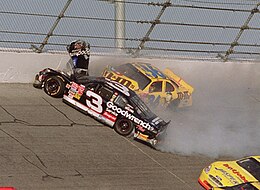 Earnhardt's No. 3 car impacts the turn four wall just after contact with Ken Schrader's 36 car. | |
| Date | February 18, 2001 |
|---|---|
| Time | 5:16 p.m. (US Eastern time (UTC−05:00)) |
| Venue | Daytona International Speedway |
| Location | Daytona Beach, Florida, U.S. |
| Cause | Auto racing accident |
| Outcome |
|
On the afternoon of February 18, 2001, American stock car racing driver and team owner Dale Earnhardt was involved in a final-lap collision in the 2001 Daytona 500, in which he crashed into a retaining wall after making contact with Sterling Marlin and Ken Schrader. He was pronounced dead at Halifax Medical Center a short time later; the cause of death was a basilar skull fracture, which was determined to have killed him instantly.[1]
Earnhardt's death was officially pronounced at the nearby Halifax Medical Center at 5:16 p.m. EST (22:16 UTC).[2] At the time of the crash, he was 49 years old. His funeral was held four days later at the Calvary Church in Charlotte, North Carolina. Earnhardt was the fourth NASCAR driver killed by a basilar skull fracture during an eight-month span, following Adam Petty in May 2000, Kenny Irwin Jr. in July 2000, and Tony Roper in October 2000. Earnhardt's death, seen on a live television broadcast with more than 17 million viewers,[3] was highly publicized and resulted in various safety improvements in NASCAR auto racing.[4]
After Earnhardt's death, NASCAR began an intensive focus on safety—mandating the use of head-and-neck restraints, installing SAFER barriers at oval tracks, setting rigorous new inspection rules for seats and seat-belts,[2] and developing a roof-hatch escape system and the Car of Tomorrow—which eventually led to the development of a next-generation race car built with extra driver safety in mind.[2] Since Earnhardt's death, no driver has died during competition in a race of NASCAR's three major series.[5]
- ^ "Earnhardt dies instantly of head injuries". ESPN Classic. November 19, 2003. Archived from the original on February 21, 2019. Retrieved February 18, 2020.
- ^ a b c Cite error: The named reference
Official Accident Report — No. 3 Carwas invoked but never defined (see the help page). - ^ "Number of TV viewers of Daytona 500 in the United States from 2000 to 2018 (in million viewers)". Statista. Archived from the original on February 19, 2019. Retrieved February 18, 2019.
- ^ Dale Earnhardt's last gift 5 years after the crash, That's Racin Archived May 2, 2009, at the Wayback Machine
- ^ Cash, Meredith (February 18, 2020). "Ryan Newman's terrifying Daytona 500 crash is being compared to the one that killed Dale Earnhardt, and some say the safety rules it spurred may have saved Newman's life". Business Insider. Archived from the original on February 18, 2020. Retrieved February 18, 2020.